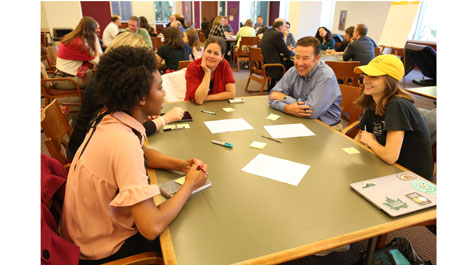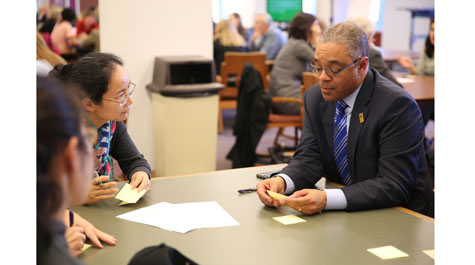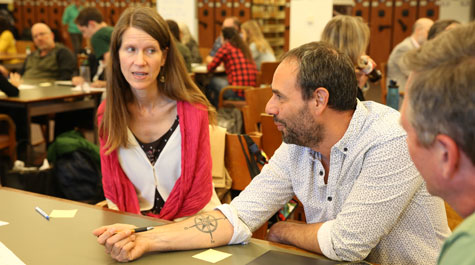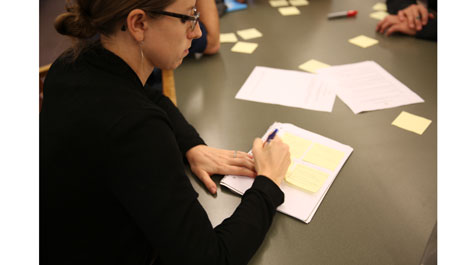‘Thinking Forward’ about service to others at W&M
Integrating service to others locally at William & Mary and beyond was the theme of the third “Thinking Forward” listening initiative forum held by President Katherine A. Rowe.
A crowd ranging from administrators and faculty to staff, students, alumni and others of varied affiliations filled the Swem Library Read and Relax area Tuesday evening to brainstorm about what the future of service looks like. It sought to build on efforts that are already embedded in the W&M experience.
“The vision for William & Mary of next year, and of the next decade, perhaps even into the next century will be informed and strengthened by our discussion,” said co-moderator Ann Marie Stock, vice provost for academic and faculty affairs and professor of Hispanic studies, during opening remarks. “So I think that’s really exciting.”
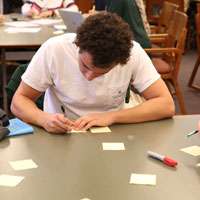 The “Thinking Forward” listening initiative consists of both in-person and online events, including a series of questions posed via Twitter and Instagram. The conversation about service will continue with an Instagram story scheduled for Nov. 7, and a @williamandmary Twitter chat on Nov. 12 at 6 p.m. The final campus conversation focusing on ideas from the three previous sessions, including those on the future of knowledge and future of work, will be held Nov. 27 at 4 p.m. at the Sadler Center.
The “Thinking Forward” listening initiative consists of both in-person and online events, including a series of questions posed via Twitter and Instagram. The conversation about service will continue with an Instagram story scheduled for Nov. 7, and a @williamandmary Twitter chat on Nov. 12 at 6 p.m. The final campus conversation focusing on ideas from the three previous sessions, including those on the future of knowledge and future of work, will be held Nov. 27 at 4 p.m. at the Sadler Center.
“I know that we’re in a position to be a model for service and civic leadership throughout the 21st century,” said co-moderator Drew Stelljes, assistant vice president for student engagement & leadership.
“In recent years, we have garnered accolades for our alumni dedication to public service. It’s something I think we should really proud of because it illustrates a longer term, or I might even suggest a lifetime, commitment to public service,” he added.
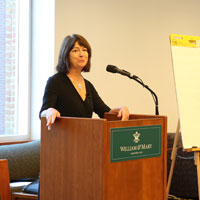 Stock and Stelljes then asked the groups of intermingled attendees at tables to imagine how such a model could be built upon for the future.
Stock and Stelljes then asked the groups of intermingled attendees at tables to imagine how such a model could be built upon for the future.
The format consisted of three segments. The groups compiled lists of what inspires them, discussed examples of service in their immediate W&M environment, then, finally, considered areas of potential growth for service. Some of the ideas were shared with the group, and all were collected on paper for future review.
Among the inspirational examples were small acts of kindness, the ability to make real change in the world, human interaction that leads to mutual understanding and selfless service to a cause greater than oneself.
Service in the immediate William & Mary environment yielded examples ranging from specific community service opportunities such as how to help local low-income families to ways of connecting leadership and service. Examples of the latter included two current or former W&M students serving on local city council and faculty doing community engaged research.
The final and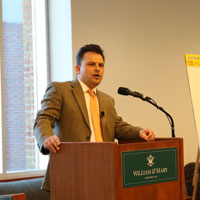 longest discussion focused on the future of service, including how William & Mary might become an institution that is known widely for preparing graduates for lives of service. Attendees were asked to discuss and compile ideas on the question of why service might matter for you as well as for W&M going forward and to help paint a picture of what the university as an engaged campus might look like 10 years from now.
longest discussion focused on the future of service, including how William & Mary might become an institution that is known widely for preparing graduates for lives of service. Attendees were asked to discuss and compile ideas on the question of why service might matter for you as well as for W&M going forward and to help paint a picture of what the university as an engaged campus might look like 10 years from now.
Another idea centered on understanding the root of service, “which is challenging the understanding of what service is in our community and kind of re-conceptualizing that, because a lot of times we think about service, we think about volunteer work,” said a participant. “But there’s so much more to it. There’s service within the faculty and staff community, and there’s also service within our peers and creating a community where other people can feel like they can be themselves.”
One group pointed out that people often get stuck on hard either/or questions, for example thinking that careers are either in a service field or not. Another suggested that starting small with acts of kindness can be broadened after graduation into larger contributions.
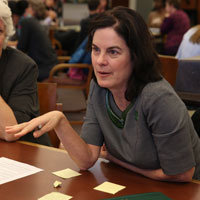 “The words that I want to say have to go with the persistence in this room of trying to break down either/or dynamics,” Rowe said. “And I really heard that strongly in the last couple of statements, seeking both — and, service that’s cultivated in the classroom as well as outside of it, outside of William & Mary as well as inside of it. Service that’s integrated into research — not separate from it, and into careers — not separate from them, regardless of whether those are careers in social services classically or in government service classically.
“The words that I want to say have to go with the persistence in this room of trying to break down either/or dynamics,” Rowe said. “And I really heard that strongly in the last couple of statements, seeking both — and, service that’s cultivated in the classroom as well as outside of it, outside of William & Mary as well as inside of it. Service that’s integrated into research — not separate from it, and into careers — not separate from them, regardless of whether those are careers in social services classically or in government service classically.
“So I think that theme of thinking outside of the classic oppositions is a really important one, and having this institution, over the decade to come, being known as the place to go if you want to be creative about how you give back, whatever your mode of work is or whatever your mode of knowledge-making is.”














